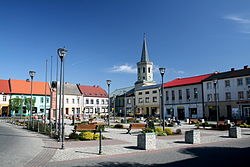Bieruń
Bieruń | |
|---|---|
 Market square in Bieruń | |
| Coordinates: 50°8′N 19°6′E / 50.133°N 19.100°E | |
| Country | |
| Voivodeship | |
| County | Bieruń-Lędziny |
| Gmina | Bieruń (urban gmina) |
| Area | |
| • City | 40.67 km2 (15.70 sq mi) |
| Population (2008) | |
| • City | 19,464 |
| • Density | 480/km2 (1,200/sq mi) |
| • Urban | 2,746,000 |
| • Metro | 5,294,000 |
| Postal code | 43-150 |
| Website | http://www.bierun.pl |
Bieruń [ˈbʲɛruɲ] (Template:Lang-de) is a town in Upper Silesia, in southern Poland, about 25 km (16 mi) south of Katowice. The town belongs to the Silesian Voivodeship since its formation in 1999, previously to Katowice Voivodeship and, before World War II, was part of the Polish Autonomous Silesian Voivodeship.
Geography
It is located in the Silesian Highlands, on the Gostynia river, a tributary of the Vistula. In the north it borders on the Metropolitan Association of Upper Silesia - metropolis with a population of about 2 million.

Bieruń is one of the towns of the 2.7 million conurbation - the Katowice urban area, and within the greater Silesian metropolitan area populated by about 5,294,000 people.[1] The population of the town itself is 19,464 (2008).[2] Bieruń includes dzielnicas Bieruń Stary, Bieruń Nowy, Ściernie, Jajosty, Bijasowice and Czarnuchowice and is bordered with Lędziny, Tychy, Chełm Śląski, Bojszowy and Oświęcim.
History
The settlement of Berouna was first mentioned in a 1376 deed, when Silesia belonged to the Bohemian Crown. The name is most probably related to the, similarly spelled, Slavic deity Perun, remains of its cultic place still present at nearby Lędziny. John II of Opava, the Přemyslid duke of Racibórz granted it town privileges in 1387. A part of the united Duchy of Opole and Racibórz Bieruń was incorporated by the Habsburg Monarchy in 1532.
With most of Silesia, it was conquered by Prussia in the First Silesian War of 1740–42 and afterwards incorporated into the Silesia Province. On 18 June 1845, a fire destroyed large areas of the village; King Frederick William IV of Prussia personally donated 9000 talers for its reconstruction. It became part of the German Empire in 1871. A cigarette and munitions factory was set up in the village in the mid-19th century. Located near the border with Lesser Poland and Austrian Silesia, Berun until 1919 was the most southeasterly town of Germany.
After the third Silesian Uprising of 1921 and the subsequent Upper Silesia plebiscite (in which 1427 or 82.1% of residents in Alt Berun and 292 or 58.4% of residents in Neuberun voted for Poland), Berun was incorporated into the Second Polish Republic and soon thereafter was officially renamed Bieruń. From 1975 until 1991 it was a district of the neighbouring Tychy municipality.
International relations
Bieruń is twinned with:
 Moravský Beroun, Czech Republic, since 1992
Moravský Beroun, Czech Republic, since 1992 Gundelfingen, Germany, since 1997
Gundelfingen, Germany, since 1997 Ostroh, Ukraine, since 2005
Ostroh, Ukraine, since 2005 Meung-sur-Loire, France since 2008
Meung-sur-Loire, France since 2008
External links
- Jewish Community in Bieruń on Virtual Shtetl
References
- ^ European Spatial Planning Observation Network (ESPON) "Archived copy". Archived from the original on 2009-07-28. Retrieved 2009-03-28.
{{cite web}}: Unknown parameter|deadurl=ignored (|url-status=suggested) (help)CS1 maint: archived copy as title (link) - ^ Powierzchnia i ludność w przekroju terytorialnym w 2008 - Central Statistical Office in Poland ISSN 1505-5507 , 13.08.2008



